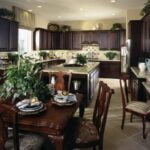Looking for a fun and thrilling activity to do at home? Why not try creating your own escape room.
In this article, we will explore the world of DIY escape room decorating ideas, perfect for setting up an immersive experience in the comfort of your own home. Whether you’re looking for a challenging puzzle adventure or simply want to create lasting memories with your friends and family, these tips and tricks will help you set the stage for an exciting escape room experience.
Setting up your own DIY escape room is all about creating the right mood and atmosphere to immerse your participants in an exciting adventure. From essential elements to theme selection, decoration ideas, puzzle placement, and more, we’ll cover everything you need to know to bring your DIY escape room to life.
With a little creativity and some budget-friendly props and supplies, you can create an authentic and captivating experience that will have everyone talking about it for weeks to come.
So if you’re ready to embark on a thrilling journey of creativity and problem-solving, stay tuned as we delve into the world of DIY escape room decorating ideas. Get ready to transform your home into an immersive environment filled with mystery, excitement, and adventure.
Essential Elements
When creating your own DIY escape room, it’s important to include essential elements that will set the stage for a thrilling and immersive experience. From the storyline to the physical setup, these elements are crucial in shaping the overall atmosphere of your escape room.
Storyline and Plot Development
The first essential element of a DIY escape room is the storyline. Whether you’re creating a murder mystery or a treasure hunt, a well-developed plot sets the stage for an engaging experience. Consider incorporating compelling characters, motives, and backstories to add depth to your escape room theme.
Physical Setup and Room Layout
Another important element is the physical setup of your DIY escape room. This includes choosing the appropriate location within your home, such as a spare bedroom or basement, and arranging furniture or props to create an authentic environment. Pay attention to details like lighting, sound effects, and hidden compartments to enhance the overall experience.
Interactive Challenges and Puzzles
Lastly, interactive challenges and puzzles are essential for keeping participants engaged and entertained. These can range from decoding secret messages to solving logic puzzles or even physical obstacles. Incorporating a variety of challenges will ensure that everyone can participate and contribute to the overall success of the escape room experience.
By focusing on these essential elements, you can effectively set the stage for a thrilling DIY escape room that will leave participants talking about it long after they’ve completed the adventure.
Theme Selection
When it comes to creating a DIY escape room, choosing the perfect theme is essential for setting the tone and atmosphere. Whether you want to transport your players to a spooky haunted house or challenge them to solve a high-stakes bank heist, the theme will dictate how you decorate and design your escape room. Here are some theme selection ideas for your DIY escape room:
- Horror: Set the scene with dark and eerie decorations, including fake cobwebs, flickering candles, and spooky sound effects.
- Adventure: Create a sense of exploration with maps, compasses, and exotic decorations that make players feel like they’re on a thrilling adventure.
- Mystery: Emphasize detective work with magnifying glasses, old newspapers, and mysterious clues hidden throughout the room.
Remember to consider your audience when choosing a theme for your DIY escape room. If you’re hosting a family-friendly event, opt for a theme that appeals to all ages. For adults-only gatherings, you can get more creative with themes that are geared towards mature audiences.
Ultimately, the key to choosing the perfect theme for your DIY escape room is to pick something that excites you and sparks your creativity. Once you have a theme in mind, you can begin brainstorming decoration ideas and puzzle concepts that will bring your chosen theme to life. With the right theme in place, you’ll be well on your way to creating an unforgettable at-home escape room experience.
Decoration Ideas
When creating a DIY escape room at home, one of the most important aspects is the decoration. The right decor can transport players to different worlds and make the experience more immersive and exciting. But coming up with creative and authentic decoration ideas can be a challenge. Here are some tips and tricks for creating an authentic and immersive environment for your DIY escape room.
First, consider the theme of your escape room. Whether you’re going for a spooky haunted house vibe or a futuristic sci-fi adventure, the decorations should reflect the theme. For example, if you’re doing a jungle-themed escape room, consider using plants, vines, and animal prints to create an immersive environment. If it’s a space-themed escape room, use metallic colors, twinkling lights, and futuristic props to set the stage.
Next, think about specific elements that can enhance the atmosphere. For example, consider using atmospheric effects like fog machines or colored lights to create an eerie ambiance for a horror-themed escape room. Incorporating sound effects like creaking doors or mysterious whispers can also add an extra layer of immersion.
Finally, don’t underestimate the power of small details in your decoration. Adding little touches like old books, antique trinkets, or handwritten notes can make all the difference in creating an authentic environment for your DIY escape room.
| Decor Theme | Immersion Elements |
|---|---|
| Jungle-themed | Plants, vines, animal prints |
| Space-themed | Metallic colors, twinkling lights, futuristic props |
| Horror-themed | Fog machines, colored lights, sound effects |
Experimenting with different decorating ideas before settling on a final design will help you achieve maximum authenticity and immersion for your DIY escape room experience at home.
Puzzle and Clue Placement
When it comes to creating your own DIY escape room, strategically placing puzzles and clues is crucial to providing a challenging yet exciting experience for your participants. To help you set the stage for a thrilling adventure, here are some tips for strategically placing challenges and riddles in your at-home escape room:
1. Create a flow of progression: Start by outlining the path that participants will take through the room, and then strategically place puzzles and clues along this route. Consider starting with an easier puzzle to give participants a sense of accomplishment early on, before ramping up the difficulty as they progress.
2. Use multiple types of challenges: Mix up the puzzles and challenges throughout the room to keep participants engaged and intrigued. Consider incorporating a variety of puzzle types, such as logic puzzles, riddles, physical challenges, and combination locks, to cater to different strengths and preferences.
3. Utilize the environment: Take advantage of the features in your chosen space by incorporating them into your puzzles. For example, use furniture, artwork, or hidden compartments to hide clues or provide hints for solving a puzzle. This adds an extra layer of immersion and excitement to the experience.
By strategically placing challenges and riddles in your DIY escape room, you can create an immersive and engaging experience that will leave lasting memories for you and your participants. So get creative with your placements and watch as your at-home escape room comes to life.
Lighting and Sound
Decorating your DIY escape room with the right lighting and sound can make all the difference in creating a truly immersive experience for your participants. The use of dim, colored, or flickering lights can add to the ambiance and mystery of the room, while well-chosen sound effects can increase tension and excitement.
When it comes to lighting, consider using string lights, black lights, or even LED candles to create an eerie or atmospheric environment. You can also use colored light bulbs to match the theme of your escape room.
In terms of sound, think about using background music or ambient noise to set the mood. For example, if you have a spooky theme, consider playing creepy music or eerie sounds like creaking doors and howling winds. For a more adventure-themed escape room, you could play exciting music that fits the setting. Additionally, consider utilizing sound effects triggered by certain actions or puzzle completions within the room to enhance the overall experience.
To further enhance the atmosphere through lighting and sound, think about ways you can leverage technology such as smart bulbs that change colors and intensity via an app controlled from your phone. Another idea is to incorporate motion sensor-activated sound effects that are sure to surprise and excite your participants as they navigate through your DIY escape room.
| Lighting Ideas | Sound Ideas |
|---|---|
| Use of string lights | Background music/audio |
| Black lights | Ambient noise/sound effects |
| Colored light bulbs | Motion sensor-activated sound effects |
DIY Props and Supplies
Are you looking to create a thrilling and immersive escape room experience right in the comfort of your own home? One key aspect of setting the stage for a successful DIY escape room is the use of creative and budget-friendly decorations. By incorporating DIY props and supplies, you can elevate the authenticity of your escape room while also keeping costs low.
One simple yet effective idea for creating DIY decorations for your at-home escape room is to utilize everyday items in unique ways. For example, repurpose cardboard boxes to create mysterious chests or secret compartments for hiding clues and puzzles. You can also use old newspapers, coffee-stained paper, or tea bags to create antique-looking documents and scrolls that add an air of mystery to your escape room.
Another option for easy and budget-friendly DIY decorations is to incorporate creative lighting effects. Utilize string lights, colored bulbs, or even LED candles to add ambiance and create an immersive environment within your escape room. By strategically placing these lighting elements throughout the space, you can enhance the atmosphere and set the mood for an unforgettable experience.
In addition, consider crafting your own themed props and decorations using inexpensive materials such as foam board, construction paper, or even polymer clay. Whether it’s creating fake locks and keys, crafting cryptic symbols or patterns, or designing personalized artifacts related to your chosen theme, the possibilities are endless when it comes to DIY prop creation.
With a little creativity and resourcefulness, you can transform simple materials into key components that will enhance the overall experience of your at-home escape room.
Bonus Tips and Tricks
Involve Friends and Family
One of the best ways to make your DIY escape room a success is to involve friends and family in the planning and execution. Not only can they help with brainstorming ideas, but having multiple perspectives can also lead to more creative and challenging puzzles. Additionally, involving others can make the experience more enjoyable for everyone as they see their ideas come to life.
Test Run Your Room
Before inviting guests to participate in your DIY escape room, it’s essential to do a test run. This will allow you to identify any potential issues with the puzzles, clues, or decorations. You can gather feedback from your test participants and make adjustments as needed to ensure a smooth and enjoyable experience for your future players.
Provide Clear Instructions
To ensure that your DIY escape room is a success, it’s crucial to provide clear instructions for the participants. Whether it’s explaining the rules of the game or providing hints when needed, clear communication can enhance the overall experience. Consider creating a printable guide or briefing participants before they enter the room so that everyone knows what to expect.
By implementing these expert tips and tricks, you can elevate your DIY escape room experience and create lasting memories for you and your participants. Whether it’s through creative puzzle design or incorporating unique themes, putting in the effort to plan and execute a successful escape room will surely be worth it in the end.
Conclusion
Creating your own DIY escape room at home can be a fun and rewarding experience for both you and your guests. By following the essential elements, selecting the perfect theme, and decorating with immersive and authentic ideas, you can set the stage for an exhilarating adventure.
The strategic placement of puzzles and clues, along with the right lighting and sound, will enhance the atmosphere and challenge your participants. And by using DIY props and supplies, you can craft creative decorations on a budget.
As you bring your DIY escape room to life, remember that the most important goal is to create memories that will last a lifetime. Whether it’s for a special occasion or just for a unique night of entertainment, the effort put into creating an immersive environment and challenging experience will not go unnoticed.
Your guests will appreciate the attention to detail that went into every aspect of the escape room, leaving them with an unforgettable experience that they’ll be talking about for years to come.
So next time you’re looking for a creative activity to enjoy with family and friends, consider creating your own DIY escape room at home. With these ideas and tips in mind, you can elevate your game night or party to new heights, sparking excitement, laughter, and memorable moments for everyone involved. So roll up your sleeves, let your imagination run wild, and get ready to bring your DIY escape room to life.
Frequently Asked Questions
How Do You Make a Cool Escape Room at Home?
Making a cool escape room at home involves creating a compelling theme, designing puzzles or challenges, and setting up the physical space to provide an immersive experience for the participants. It’s important to think about the flow of the game, the difficulty of the puzzles, and how to incorporate interactive elements that engage players.
Can You Design Your Own Escape Room?
Yes, you can absolutely design your own escape room. Start by choosing a theme or story for your escape room, then brainstorm different puzzles, riddles, or challenges that fit within that theme. Consider how to create a sense of progression and excitement as players work their way through the room.
What Are the 7 Common Escape Room Puzzles?
The seven common escape room puzzles include logic puzzles (such as Sudoku or pattern recognition), math-based puzzles (like equations or numerical patterns), word puzzles (crossword clues or anagrams), hidden object puzzles (finding hidden items in the room), physical challenges (manipulating objects or moving through obstacles), observation puzzles (spotting details or patterns), and code-breaking puzzles (cracking codes or ciphers).
Each type of puzzle offers a different mental challenge for participants and adds variety to the escape room experience.

I’m thrilled to be your companion on this exciting journey through the world of home decor and design. With a passion for turning houses into homes and a keen eye for the finer details, I’m here to help you transform your living spaces into beautiful, functional, and meaningful havens.





